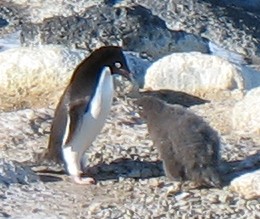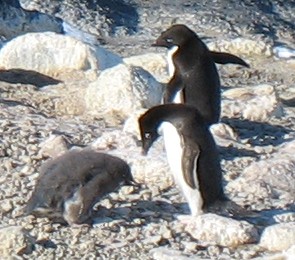Home|Glossary|Links|Journal|Maps
Of
Ponies and Penguins
| I
was sitting in an office
at Crary Lab in McMurdo Station waiting impatiently for eight
o’clock to come around. That’s the time that helicopter
operations coordinator, Liz Kauffman, usually puts out the helo
schedule. I wanted to see if researcher Penney Miller and I were
going to Pony Lake the next day. Pony Lake is
located near Cape Royds and, like McMurdo
Station, is on Ross Island. The lake
was named after the Manchurian ponies that Ernest Shackelton
brought to Antarctica during his 1907-1909 Nimrod expedition in
which he attempted to reach the South Pole. The ponies were the
first to set foot on the continent and were stabled at a hut constructed
near the lake. Penney, who is a professor at the Rose-Hulman Institute
of Technology in Indiana, wanted to collect some last lake samples
from Pony. I was going to help out. Penney along with my advisor
Diane McKnight and others is studying Pony Lake because it has
an extremely high concentration of organic matter. The main reason
for this is that the lake is located next to an Adelie penguin
colony, which is a place where hundreds if not thousands of penguins
nest. |
|
In 1908
Ernest Shackleton and three companions – Eric Marshall,
Jameson Adams, and Frank Wild – attempted to reach
the south geographic pole. They launched their expedition
from the Cape Royds hut near Pony Lake. Just 90 miles
from the pole, Shackleton, the leader of the group, had
to make an agonizing decision –
(1) continue with his men and become the first to reach
the south pole but with a high risk that their dwindling
supplies would run out and they would starve to death
on their return journey
or
(2) turn back at this point while supplies
would likely last.
What
would you do?
Answer
>>
|
|
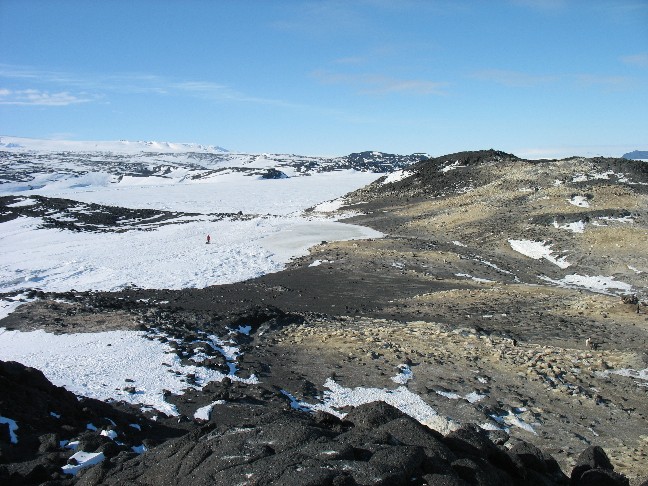
Pony Lake |
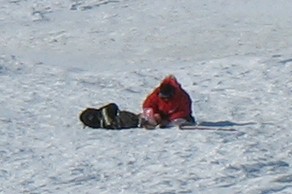
Penney
sampling lake water
|
Adelies are one of only two types of
penguins that live on the Antarctic mainland. They are named after
the wife of one of the early (1830s) Antarctic explorers, Frenchman
Dumont d’Urville. With the adults rarely weighing in at more
than 11 pounds and being only around 18" tall, Adelies
are one of the smaller penguins. They migrate to colonies in October,
returning year after year if possible to their birth grounds. The
Adelies lay their eggs on rocky, ice-free beaches in November, and
chicks hatch in December. At the time of our visit, the chicks were
around six to seven weeks old.
In order to protect the penguins, environmental
laws prevent people except penguin researchers from going into the
colony. But Penney, our helicopter pilot Paul Murphy, and myself
were still able to observe the penguins from a distance and capture
some of the action with a zoom-in camera lens. David Ainley who’s
been studying the Adelies since the late 1960s provided some insight
into what is going on at the colony. Check out these photos!
- Karen
Click
on the photos to see a larger view.
|
Adelie females
typically lay two eggs. The parents take turns incubating
them over a five week period. When the chicks are born they
are covered only in down feathers.
These feathers have excellent
thermal properties that help keep the chicks warm. Down has
the texture of polar fleece and gives the chicks in these
photos their fluffy appearance.
|
|
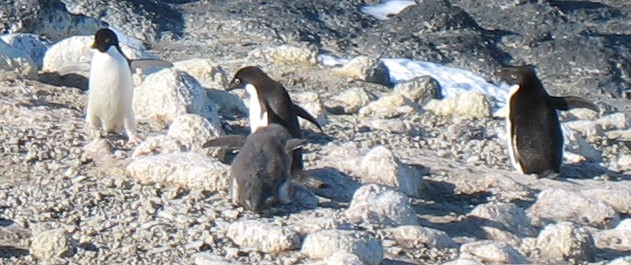 |
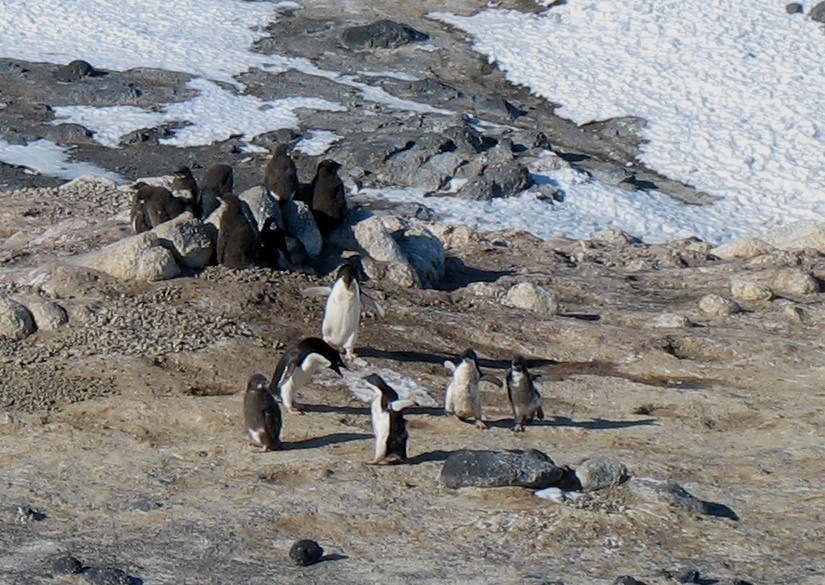 Chicks
and parents identify each other both through the position of the nest
and through calls, explains Ainley. Calling to its chick is what the
adult penguin in this photo with its neck stretched out is doing.
Also in this photo are two chicks chasing some adults in the hopes
of getting food. The chasing serves to weed out weak and unhealthy
chicks. In addition, it helps parents distribute food more evenly
says Ainley, because a chick that is hungrier will likely chase more
vigorously than a chick that is less hungry. The enthusiastic chases
of the young penguins were pretty comical to watch and sometimes we
saw the chicks apparently trip and fall down in their excitement.
But they just got right back up and kept going!
Chicks
and parents identify each other both through the position of the nest
and through calls, explains Ainley. Calling to its chick is what the
adult penguin in this photo with its neck stretched out is doing.
Also in this photo are two chicks chasing some adults in the hopes
of getting food. The chasing serves to weed out weak and unhealthy
chicks. In addition, it helps parents distribute food more evenly
says Ainley, because a chick that is hungrier will likely chase more
vigorously than a chick that is less hungry. The enthusiastic chases
of the young penguins were pretty comical to watch and sometimes we
saw the chicks apparently trip and fall down in their excitement.
But they just got right back up and kept going!
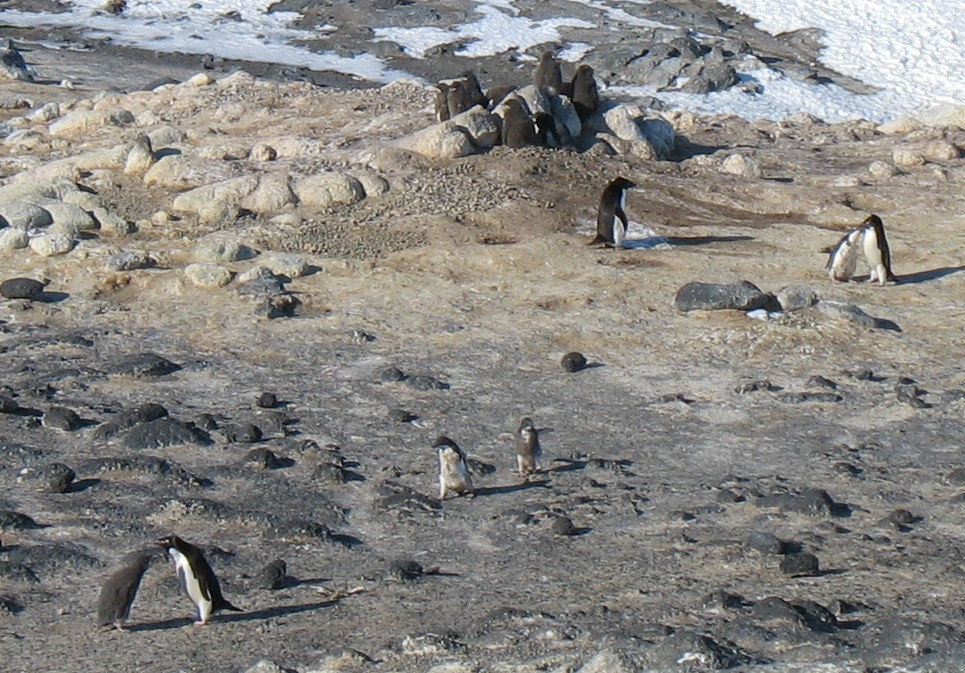 The
chicks in the lower left and upper right of this photo have caught
up with a parent, and the adults are feeding the chicks. An adult
does this by regurgitating food into the chick’s gaping bill.
The food consists mainly of fish and krill that the adults have consumed
while at sea.
The
chicks in the lower left and upper right of this photo have caught
up with a parent, and the adults are feeding the chicks. An adult
does this by regurgitating food into the chick’s gaping bill.
The food consists mainly of fish and krill that the adults have consumed
while at sea.
Again, the two chicks in the middle
of the photo are chasing some adults.
When the chicks are born, one parent
stays with them at all times to keep them warm and prevent skuas,
which are large gull-like birds, from stealing and eating the chicks.
The other parent goes out to sea to find food. When the chicks reach
three to four weeks of age though, this guard phase ends and what’s
known as a crèche phase begins. The chicks are growing rapidly
and require more food. Now both parents must go to sea at the same
time and hunt. The unattended chicks gather into groups or crèches,
like the one in this photo, for protection against skuas and the elements.
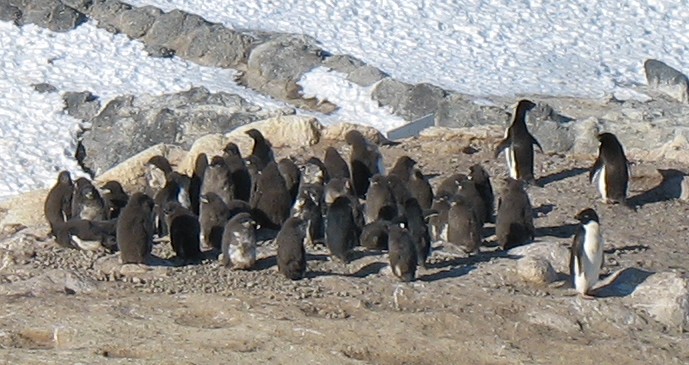
If you look closely, you can see that
some of the chicks have started to molt or shed their brown/charcoal
down feathers to reveal the sleek, black and white waterproof feathers
of an adult. They need to molt completely before they will be ready
to swim and dive Ainley notes.
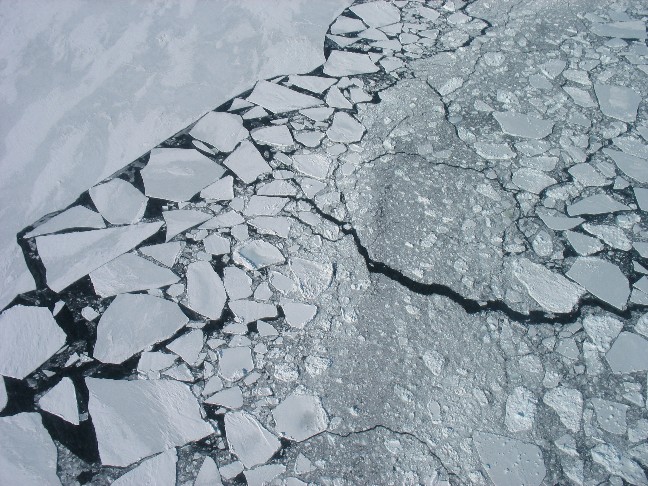 Extra
sea ice has been making life rough for the Cape Royds Adelies. Giant
icebergs calved off the Ross Ice Shelf in 2000, and the icebergs have
prevented winds from blowing out the sea ice. This has meant that
parents have had to walk some 80 km one way to open water and has
reduced the frequency with which parents have been able to feed their
young.
Extra
sea ice has been making life rough for the Cape Royds Adelies. Giant
icebergs calved off the Ross Ice Shelf in 2000, and the icebergs have
prevented winds from blowing out the sea ice. This has meant that
parents have had to walk some 80 km one way to open water and has
reduced the frequency with which parents have been able to feed their
young.
A few years ago there were 4000 pairs
of Adelies breeding at Cape Royds, says Ainley. This year that number
has been cut to 2400 pairs. Sometimes ice breaker ships unintentionally
give the Adelies a brief respite though. These ships are specially
equipped to break through sea ice and create paths of open water –
like the one in this photo – so that other resupply ships can
reach McMurdo Station.
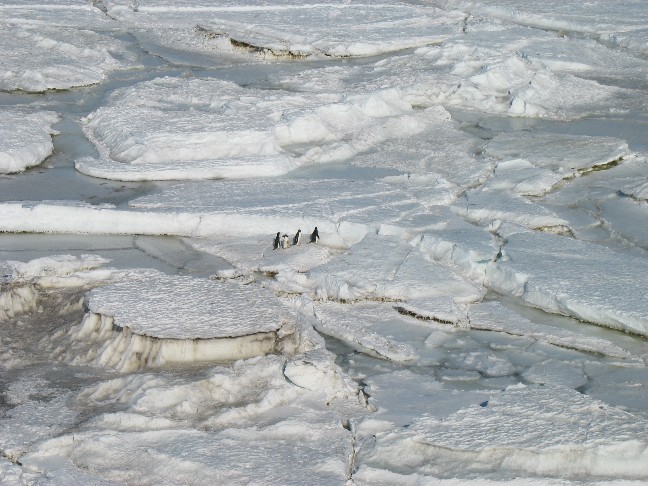 These
parents are going to get food for their chicks, says Ainley. But they
won’t be doing this for much longer. In one to two weeks, by
mid-to-late February, they and the just fledged chicks with a brand
new set of adult feathers will start their winter migration to more
northern waters. For the young fledglings, this will be their first
experience diving in the Antarctic Ocean and their first journey away
from their colony home.
These
parents are going to get food for their chicks, says Ainley. But they
won’t be doing this for much longer. In one to two weeks, by
mid-to-late February, they and the just fledged chicks with a brand
new set of adult feathers will start their winter migration to more
northern waters. For the young fledglings, this will be their first
experience diving in the Antarctic Ocean and their first journey away
from their colony home.
References:
• Shackleton, Ernest. The Heart of the Antarctic –
The Farthest South Expedition: 1907-1909. Penguin Putnam: New
York, NY, 2000.
• Stone, Emily. Ice Conditions
Send Penguins Packing. The Antarctic Sun, January 29, 2006.
http://antarcticsun.usap.gov
• Lonely Planet Antarctica Guide
– 2003.


